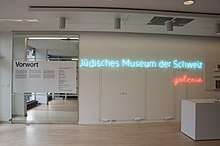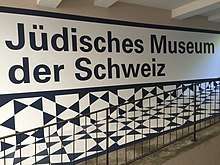Jewish Musem of Switzerland
The Jewish Museum of Switzerland (German: Jüdisches Museum der Schweiz) in Basel was opened in 1966 as the first Jewish museum in the German-speaking world after the Second World War.[1] The museum tells the cultural history of the Jews in the area of today’s Switzerland and of Judaism as in a social, cultural and religious context.[2]


History
Founded upon initiative of the chevra kadisha (funeral association) Espérance, the museum was entrusted to director Dr. Katia Guth-Dreyfus in 1966, who led the museum until 2010 when she was succeeded by Dr. Gaby Knoch-Mund, and then by Dr. Naomi Lubrich, the current director, in 2015.[3]
Since 2016, Lubrich has re-organized the permanent exhibit, attracted new visitors and gained the museum media attention.[4]
Collection
The Jewish Museum of Switzerland’s permanent collection represents regions from Basel to Riga, from Aleppo to Eilat, and from Spain to South America. The collection encompasses tombstones dating from the Middle Ages and contemporary documents, Hebrew books printed by the famous Basel printing houses and mementos of the Zionist Congresses enrich the collection.[5] The museum is also collecting contemporary objects -- Judaica—as well as objects of art and of everyday life.[6]
The first Swiss Judaica were collected by the Swiss Museum of Folklore (now Museum der Kulturen Basel).[7] The museum’s collection expanded after 1966 to include objects from Basel and the Upper Rhine, from the two Surbtal villages Endingen and Lengnau as well as from the remainder of Switzerland and Europe.[8]
Exhibitions
The Jewish Museum of Switzerland has presented various temporary exhibitions.[9]
Group exhibition Neuland in 2017, was the first exhibition in Switzerland to celebrate the 120th anniversary of the first Jewish Congress held in Basel The painters presented by Boaz Arad, Shai Yehezkeli, Israel Herzl and Yael Bar Tanna. The curator was Dr. Naomi Lubrich
Another exhibition The Diary: How Otto Frank brought Anne‘s Voice from Basel to the World shows the history of Anne Frank’s diary from the perspective of her father, Otto Frank. Otto gave Anne the diary, which she wrote in hiding from 1942 to 1944. The exhibit displayed items such as Anne Frank’s hand-embroidered pyjama-pouch as well as a typewriter used by Otto Frank.[10]
The exhibition titled ISRAELITES: Seven Photographic Journeys was on display from March 29, 2019 until September 1, 2019. ISREALITIES presents the photographic journeys of seven photographers: Philippe Halsman, David Seymour (called CHIM), Erich Hartmann, Micha Bar-Am, Patrick Zachmann, Thomas Dworzak, and Oded Balilty give a tour through the British Mandate for Palestine, guiding the visitors through the founding of the Jewish State to present-day Israel.[11]
Locations
As of 2018, the museum has been active in two locations in Basel.
The original location, just at the edge of the historic center at Kornhausgasse 8, is home to the permanent collection of objects.
The second, newer location that opened in 2018 near the University of Basel is at Petersgraben 31, and is the venue for its temporary exhibits in a fresh, modern two-story space that is wheelchair accessible.
See also
References
- https://travelguide.michelin.com/europe/switzerland/basle-town/basel/jewish-museum-switzerland
- https://www.aejm.org/members/jewish-museum-of-switzerland/
- https://www.juedisches-museum.ch/en/about-us.html
- http://brosenose.com/2019/01/basel-switzerland-the-jewish-museum.html
- https://www.museenbasel.ch/museen/en/museen/detail/juedisches-museum-der-schweiz.html
- https://www.basel.com/en/Media/Attractions/Museums/Juedisches-Museum-der-Schweiz
- https://www.mkb.ch/en/museum/history.html
- https://www.aejm.org/members/jewish-museum-of-switzerland/
- https://www.juedisches-museum.ch/en/Current-exhibitions.html
- https://www.juedisches-museum.ch/en/the-diary.html
- https://www.juedisches-museum.ch/en/Isrealities-seven-photographic-journeys.html
External links
- Jewish Museum of Switzerland website
- JewishEurope.org
- Jewish-Heritage-Europe.eu
- Israel Science and Technology Directory.com
- MerianVerlag.ch